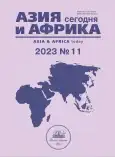Iran and Saudi Arabia: a New Détente?
- 作者: Podrezov M.A.1
-
隶属关系:
- Institute for Oriental Studies, Russian Academy of Science
- 期: 编号 11 (2023)
- 页面: 48-55
- 栏目: Politics, economics
- URL: https://journals.rcsi.science/0321-5075/article/view/249714
- DOI: https://doi.org/10.31857/S032150750028626-0
- ID: 249714
如何引用文章
全文:
详细
作者简介
Mikhail Podrezov
Institute for Oriental Studies, Russian Academy of Science
ORCID iD: 0000-0002-4385-2102
Russian Federation, Moscow
参考
- Аятолла Хомейни. Исламское правление. Алматы: Атамура, 1993. 141 с.
- Takeyh R. Guardians of the revolution. Iran and the World in the Age of the Ayatollahs. Oxford: Oxford University Press, 2009. 310 p.
- Jones T. 2006. Rebellion on the Saudi periphery: modernity, marginalization, and the Shia uprising of 1979. International Journal of Middle East Studies. № 38(2), pp. 213–233. doi: 10.1017/S0020743806412320
- Бирюков Е. Взаимоотношения Саудовской Аравии и Ирана в сфере безопасности. Россия и мусульманский мир. 2017. № 12 (306). С. 60–85.
- Кузьмин В.А., Соколов Н.В. Противостояние Саудовской Аравии и Ирана в зоне Персидского залива в конце XX – начале XXI веков. Научный диалог. 2017. № 8. С. 241–260.
- Кузнецов А.А. Суннитско-шиитские противоречия в контексте геополитики региона Ближнего Востока (1979–2016). М.: Русский фонд содействия образованию и науке; изд-во Университета Дмитрия Пожарского, 2021. 352 с.
- Mousavian H. Saudi Arabia is Iran’s new national security threat. HuffPost. 03.06.2023. https://www.huffpost.com/entry/saudi-arabia-iran-threat_b_10282296 (accessed 23.07.2023)
- Мелкумян Е.С. 2021. Израиль во внешней политике ОАЭ: от конфронтации к нормализации. Вестник МГИМО Университета. № 14(2). С. 107–118. doi: 10.24833/2071-8160-2021-2-77-107-118
- Косач Г.Г. Саудовская Аравия: «религиозное государство» или «государственная религия»? Религия и общество на Востоке. 2017. № 1. С. 7–50.
- Васильев А.М. Саудовская Аравия. Сальман ибн Абд аль-Азиз и Мухаммед ибн Сальман. Азия и Африка сегодня. 2023. № 3. С. 5–20. doi: 10.31857/S032150750024989-9
- Щегловин Ю.Б. Что стоит за внесением изменений в школьные учебники в Саудовской Аравии. Институт Ближнего Востока. 31.05.2023. http://www.iimes.ru/?p=98201 (accessed 23.07.2023)
- Illaik H. Exclusive: The hidden security clauses of the Iran-Saudi deal. The Cradle. 12.03.2023. https://thecradle.co/article-view/22445/exclusive-the-hidden-security-clauses-of-the-iran-saudi-deal (accessed 03.06.2023)
- Assi A. Saudi Failures in the Mashreq and the Beijing Agreement. Carnegie Endowment for International Peace. 25.04.2023. https://carnegieendowment.org/sada/89606 (accessed 08.07.2023)
- Васильев А.М. Саудовская Аравия: укрепление вертикали власти в условиях ломки старой мир-системы. Азия и Африка сегодня. 2023. № 5. С. 5–16. doi: 10.31857/S032150750025680-0
- Baker P., Hubbard B. Biden to Travel to Saudi Arabia, Ending Its ‘Pariah’ Status. The New York Times. 02.06.2022. https://www.nytimes.com/2022/06/02/us/politics/biden-saudi-arabia.html (accessed 01.10.2023)
- نظم نوینی در منطقه غرب آسیا در حال شکل گیری است .اعظم ملایی. (Molayi A. A new order is being formed in the West Asian region). Iranian Diplomacy. 07.05.2023. (In Pers.). http://irdiplomacy.ir/fa/news/2019295 (accessed 10.07.2023)
- Wintour P. Saudi-Iranian detente is fragile but potential for the Middle East is huge. Guardian. 08.05.2023. https://www.theguardian.com/world/2023/may/08/saudi-iranian-detente-is-fragile-but-potential-for-the-middle-east-is-huge (accessed 15.07.2023)
- پنج رویکرد مهم ازسرگیری روابط دیپلماتیک ایران و عربستان مریم خالقی نژاد. (Five important approaches to resume diplomatic relations between Iran and Saudi Arabia). Iranian Diplomacy. 09.04.2023. (In Pers.). http://irdiplomacy.ir/fa/news/2018692 (accessed 10.07.2023)
- Russell C. Column: China’s 2023 crude oil imports set for 6.2% rise, but risks prevail. Reuters. 28.03.2023. https://www.reuters.com/markets/commodities/chinas-2023-crude-oil-imports-set-62-rise-risks-prevail-russell-2023-03-28/ (accessed 23.07.2023)
- Hale E. Can China replace the US in the Middle East? Al Jazeera. 25.04.2023. https://www.aljazeera.com/features/2023/4/25/can-china-replace-the-us-in-the-middle-east/ (accessed 20.07.2023)
补充文件










